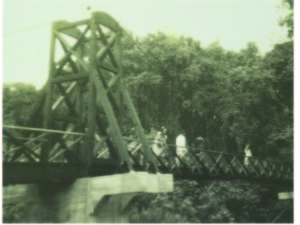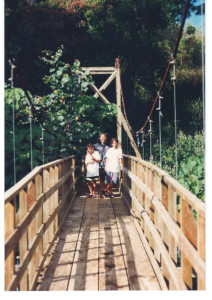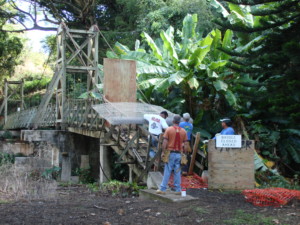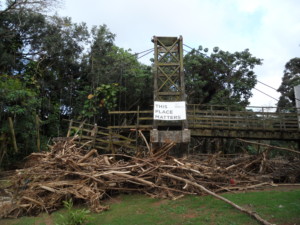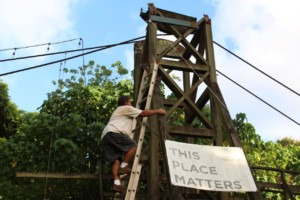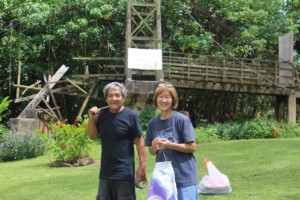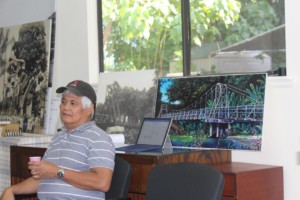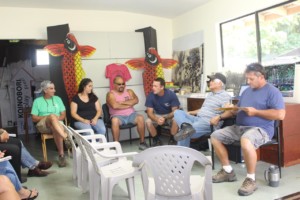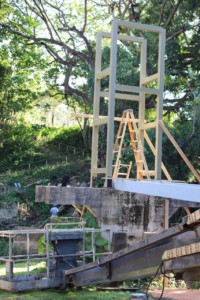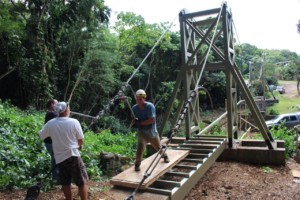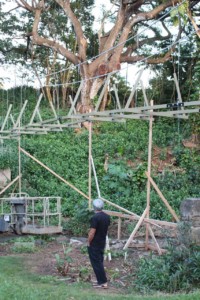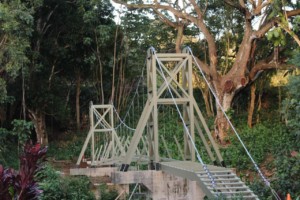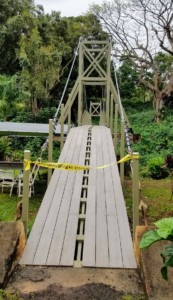The Kapaia Swinging Bridge is a gateway to life in a bygone era before automobiles. Immigrant villagers traveled by foot over the Kapaia Stream via a low foot bridge which was frequently washed out by heavy rains. In 1948 a suspension bridge was constructed by the County of Kaua‘i. As the automobile emerged and went on to become the major form of transportation, the necessity for the bridge lessened for transport and increased as an important symbol of an extremely influential era in the history of Hawai‘i that informs local culture to this day.
Below is the story of a determined community who saw value in preserving Kapaia Swinging Bridge, making it accessible to all and saving an important piece of Kauai history. (See the photo gallery & timeline below at the end of the article.)
Historic Hawaii Foundation: Briefly describe the history of the bridge.
Kapaia Foundation: A foot bridge across Hanamaulu Stream was used daily to go to and from work, school, shopping, church and play. Often, heavy rains swept through the stream, washing away the low foot bridge, creating a huge inconvenience for the villagers. Archaeological remnants show that at least two attempts were made to rebuild the bridge with cement footings. Finally, in 1948, a suspension bridge, funded by the County of Kauai, was constructed by Contractor I. Maeda for the community of Kapaia. The bridge was called “Kapaia Swinging Bridge” by the local community.
The Kapaia Swinging Bridge is associated with the sugar plantation era of Hawaiian history. It was an infrastructure of extreme necessity for the sugar plantation immigrants living in the camps of Kapaia. Most of the traversing was done by people walking from their camp homes, across the bridge, to all of the activity on the other side of Hanamaulu Stream. Japanese children crossed daily to attend Japanese School. Plantation laborers met across the bridge at 5 a.m. every morning to walk together to the trucks that transported them to the sugar fields. Housewives walked back and forth the bridge to do their daily grocery shopping and to visit friends. On Sundays, families crossed the bridge to get to the Catholic, Buddhist, Mormon, Methodist, or Chinese churches. These are just a few examples demonstrating the integral role of the Kapaia Swinging Bridge in the daily life of Kauai’s sugar plantation immigrant population. Its existence allowed people of diverse backgrounds to interact with each other, resulting in tolerance, understanding, acceptance, and respect for all people.
On August 23, 2008, the Kapaia Swinging Bridge was placed on the Hawaii State Register of Historic Places by the Hawaii Historic Places Review Board, confirming its invaluable historical significance.
HHF’s Note: Kapaia Swinging Bridge was listed as one of Hawai‘i’s Most Endangered Places in 2011 due to neglect. The bridge’s wooden structure was badly rotted with last known repairs dating back to 1965. A setback in March, 2012 due to heavy rains, a fallen tree and resulting flood damaged the bridge further.
HHF: Describe the goal of the preservation project.
Kapaia Foundation: The goal is to rebuild the Kapaia Swinging Bridge as close to original as possible. Ultimately, we look forward to an alternate route that integrates walking, beauty, history and nature.
HHF: Who is involved in the project?
Kapaia Foundation: Kapaia Foundation is responsible for this project. Ron Agor, of Agor Jehn Architects, is the volunteer project manager and H.D. Construction Corporation is the builder. County of Kauai provided major funding with a $231,000 grant for the Kapaia Swinging Bridge rebuild project.
HHF: Walk us through the process. Where are you now?
Kapaia Foundation: The process has been long and arduous. Money was allotted for the restoration of the bridge and has been more than a decade in process.
- 2006: bridge was closed due to maintenance neglect by County of Kauai. Community recognized the importance of restoring and preserving the historical structure. Their desire was expressed to county officials. Money was allotted for the restoration of the Bridge.
- 2006-2016: Community spent 10 years testifying before county council, community meetings and presentations, meetings with county administration, petitions, etc.
- 2016: County asked Kapaia Foundation to take ownership of the Kapaia Swinging Bridge, along with $231,000 to assist in rebuilding it. Knowing that it would be the only way the bridge would have a chance to exist, Kapaia Foundation accepted the county’s offer.
- 2017: After approval from the Kauai Historic Preservation Review Commission, H.D. Construction proceeded with the Kapaia Swinging Bridge rebuild project in September 2017. Contractor is following building specs from the original structure. The concrete foundation and much of the tower steel brackets, as well as some of the original hanger hardware, is being used on the new bridge. All of the wood elements and the steel cables are new because they were either not salvageable or unsafe to reuse.
- 2018: Rebuilt bridge is nearing completion. Completion target date is June 2018.
What’s special about Kapaia Swinging Bridge and why does preserving it matter? Voices from the community that saved it share their thoughts.
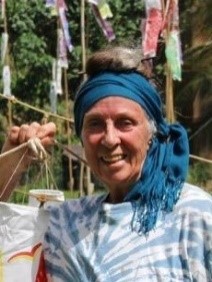 If a historical building or place are destroyed or left to ruin, long term residents lose their faith in their local governments. Eventually they lose their sense of place, learned from their ancestors, and their own identity and commitment to integrity…a great loss.
If a historical building or place are destroyed or left to ruin, long term residents lose their faith in their local governments. Eventually they lose their sense of place, learned from their ancestors, and their own identity and commitment to integrity…a great loss.
Since this project was accomplished from grass root efforts over a long period of years, with many nearby and far away committed residents of Kauai being involved, this is very admirable in today’s fast paced society.
Marj Dente, Member, Kapaia Foundation

Kapaia Swinging Bridge is located right in Lihue and off of Kuhio Highway and yet still retains the peaceful calm magical feel of old Kauai. The swinging bridge spans the Hanamaulu River. On one side is the Immaculate Conception Catholic Church and on the other side is the Lihue Hongwanji Buddist Mission. I hope this bridge will facilitate connections between these two faith communities.
David Monasevitch, Charter Member, Kapaia Foundation

What is special about this bridge and its location is the feeling of old Kauai. This swinging bridge is central to that feeling and it really does bring you to simpler times and connects you to the beauty of nature.
Preserving the bridge is important to keep the rich history of the Island alive.
Nina Monasevitch, Board Member & Charter Member, Kapaia Foundation

The Kapaia Swinging Bridge can be fully appreciated by visiting it in its actual setting and by knowing the rich history of its existence.
Kapaia Swinging Bridge sits over Hanamaulu Stream, at the foot of a huge old monkeypod tree, surrounded by a caringly maintained lawn and a lush vegetation of longun, java palm, African tulip trees; hau bush, red ginger and many more native and introduced flora common to Hawaii. Wild, as well as domesticated chickens roam the area along with the endangered, native alae ula duck.
The bridge structure itself is a sight to behold. The two wooden towers are assembled with custom planed timber. The top cable saddle arch perfectly complements the diagonal cross support under it. The diagonal cross railings reinforce the structure’s feel of strength, which transcends to the strength of the people for whom the bridge was originally built. Truly, there is no bridge like it in the world!
The Kapaia Swinging Bridge has a story to tell. It is a story about the people for whom the bridge was originally built and how those people have impacted our lives today. We can read their stories in history books. But to be able to see, touch and feel their presence through the Kapaia Swinging Bridge brings history to life. This is the essence of historic preservation.
Laraine Moriguchi, Charter Member, Kapaia Foundation
HHF: What were some of the challenges to saving it?
Kapaia Foundation: Resistance from county officials.
Discouragement from naysayers.
Funding.
HHF: What did it take to overcome them?
Kapaia Foundation: Perseverance, patience, commitment and determination.
Community support.
Compromise and collaboration.
HHF: What’s your community’s vision for the future of this unique bridge?
Kapaia Foundation: Our vision is to see the Kapaia Swinging Bridge used and enjoyed by the entire community. Furthermore, we want people to appreciate the bridge as a valuable piece of history. Our ultimate goal is to honor those who came before us by keeping this historical treasure as a bridge connecting the descendants of the native and immigrant laborers to each other; and as a bridge welcoming those desiring to be part of a truly special culture.
Note: The completed bridge will be a historic monument. The public will not be able to walk on it until we complete the next phase of an ongoing project. We will work on securing public access and resolving liability concerns. The County of Kauai and private landowners have expressed a desire to work with Kapaia Foundation to accomplish this task sooner rather than later.
HHF: What advice do you have for other communities working to preserve a historic place?
Our advice is to take the first step and keep going until you finish.
Contributors:
Marj Dente: Marj was born during the Great Depression of the 1930’s in Connecticut and lived there for twenty years. The entire East Coast of the United States was filled with large historical buildings, bridges and parks that were hundreds of years old dating back to the Revolutionary War with Great Britain all the way from Boston, Massachusetts to Williamsburg, Virginia. and all are still in good condition. Manytimes she passed over the great George Washington and Brooklyn Bridges in New York State, both built in the 1800’s.
As a child, Marj was taught never to throw anything away and learned to repair anything if it broke. She still lives by this value system and has passed this onto her three daughters. With that background and the destruction of the Kapaia Bridge, once Marj learned of the extensive history of the bridge and the large community it supported, she has been a champion of the grassroots effort to repair this bridge. Preserving the actual bridge that local residents had become so accustomed to over the years and hearing the countless stories from their surviving relatives, in her opinion is a very necessary value to possess and to pass onto the many generations that follow.
David Monasevitch: David came to Kauai in 1995 to teach elementary school. He and his wife, Nina, moved to Kapaia in 2005. The bridge was in unsafe disrepair so the county fenced off access and David became involved in the save Kapaia Swinging Bridge restoration project. He learned, first hand, that the commitment and perseverance of a few people makes all the difference.
Nina Monasevitch: Nina is a board member of the Kapaia Foundation. She also serves on several boards focused on ocean conservation. Nina moved to Kauai in 1978 and worked for many years in the dive and hospitality industry.
Laraine Moriguchi: Laraine is a charter member of Kapaia Foundation. She was born and raised on Kauai. Her parents grew up in Kapaia and she still has family living and working in this special place. Preserving and promoting the rich history of Kapaia Valley is Laraine’s passion. Saving Kapaia Swinging Bridge is her mission. With the help and support of many, the mission is almost accomplished!
Kapaia Swinging Bridge Photo Timeline (Left to right above.)
- Ca 1948 Oldest known photo of Kapaia Swinging Bridge, which was built in 1948.
- Ca 1991 County of Kauai replaced deck and built new straight post railings. Michielle Inagaki Looser and sons Derek and Kurt were visiting from Longmont, CO. (Michielle’s dad, youngest child of the Inagaki family, was raised in Kapaia) Records show that repairs to the bridge was also done in 1965 without altering the original design.
- Ca 1998 Harumi “David” Inagaki (Laraine’s dad)
- 2007 Bridge barricaded by county workers a year after it was closed
- 2011 We participated in National Trust for Historic Preservation’s This Place Matters to spotlight the historic Kapaia Swinging Bridge, one of many projects undertaken throughout the years to keep interest in restoring the historic structure.
- 2011 Bridge before the storm.
- March 2012 Aftermath of storm that broke the bridge. Many were discouraged but a few dedicated people was enough to keep the project afloat, resulting in where we are today, working to rebuild the Kapaia Swinging Bridge before September, 2018.
- 2015 KF member Kimo St. John stringing light to attract attention to its existence.
- April 2017 KF members Bill Lanoza & Larine Moriguchi. In background is KSB falling apart.
- Sept 2017 10 meeting with Ron Agor KSB rebuild project manager.
- Sept 2017 Volunteer organization mtg with Ron Agor, Sept 2017
- Towers under construction.
- Jan 2018 13 Construction crew tightening cables
- Feb 2018 Bill Lanoza checking out progress of bridge rebuild.
- Mar 2018 Towers complete
- April 2018 Construction should be complete by end of May.



